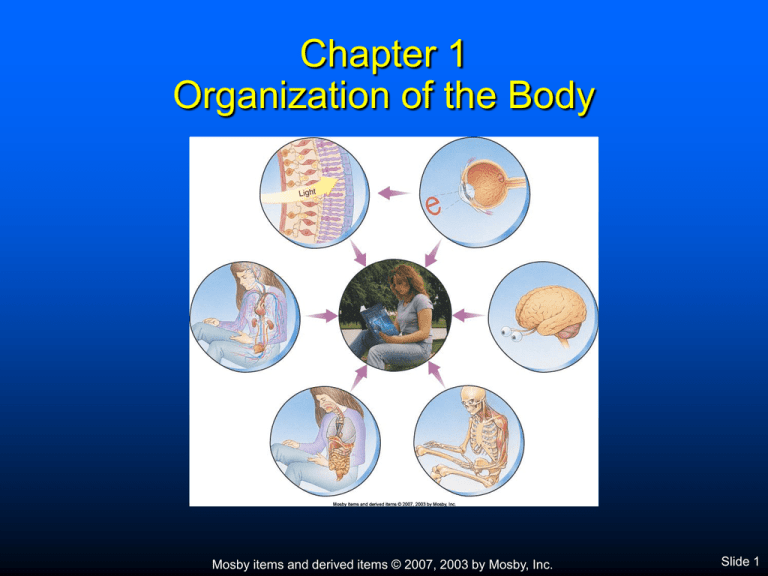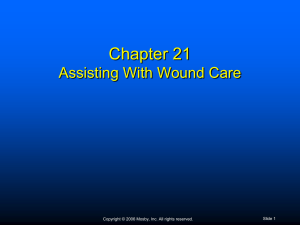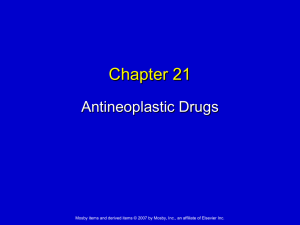Ch 1 notes
advertisement

Chapter 1 Organization of the Body Mosby items and derived items © 2007, 2003 by Mosby, Inc. Slide 1 Science and Society • Science involves logical inquiry based on experimentation (Figure 1-1) Hypothesis—idea or principle to be tested in experiments Experiment—series of tests of a hypothesis; a controlled experiment eliminates biases or outside influences Mosby items and derived items © 2007, 2003 by Mosby, Inc. Slide 2 Scientific Method Mosby items and derived items © 2007, 2003 by Mosby, Inc. Slide 3 Science and Society • Theory—a hypothesis that has been proven by experiments to have a high degree of confidence • Law—a theory that has an unusually high level of confidence • The process of science is active and changing as new experiments add new knowledge Mosby items and derived items © 2007, 2003 by Mosby, Inc. Slide 4 Science and Society • Science is affected by culture and culture is affected by society Mosby items and derived items © 2007, 2003 by Mosby, Inc. Slide 5 Anatomy and Physiology • Anatomy and physiology are branches of biology concerned with the form and functions of the body • Anatomy—science of the structure of an organism and the relationship of its parts Mosby items and derived items © 2007, 2003 by Mosby, Inc. Slide 6 Anatomy and Physiology • Gross anatomy—study of the body and its parts using only the naked eye (Figure 1-2) • Microscopic anatomy—study of body parts using a microscope Cytology—study of cells Histology—study of tissues Mosby items and derived items © 2007, 2003 by Mosby, Inc. Slide 7 Anatomy and Physiology • Developmental anatomy—study of human growth and development • Pathological anatomy—study of diseased body structures • Systemic anatomy—study of the body by systems Mosby items and derived items © 2007, 2003 by Mosby, Inc. Slide 8 Anatomy and Physiology • Physiology—science of the functions of organisms; subdivisions named according to Organism involved—human or plant physiology Organizational level—molecular or cellular physiology Systemic function—respiratory, neurovascular, or cardiovascular physiology Mosby items and derived items © 2007, 2003 by Mosby, Inc. Slide 9 Language of Science and Medicine • Scientific terms are often based on Latin or Greek word parts • Terminology tool is provided in pull-out section near the front of this textbook Mosby items and derived items © 2007, 2003 by Mosby, Inc. Slide 10 Language of Science and Medicine • Terminologia anatomica Official list of anatomical terms Terms listed in Latin, English, and by number Avoids use of eponyms (terms based on a person’s name) • Physiology terms do not have an official list but follow the same principles as Terminologia Anatomica Mosby items and derived items © 2007, 2003 by Mosby, Inc. Slide 11 Characteristics of Life • A single criterion may be adequate to describe life, as in following examples: Autopoiesis—living organisms are self-organized and self-maintaining Cell theory—if it is made of one or more cells, it is alive Mosby items and derived items © 2007, 2003 by Mosby, Inc. Slide 12 Characteristics of Life • Characteristics of life considered most important in humans: Responsiveness Absorption Conductivity Secretion Growth Excretion Respiration Circulation Digestion Reproduction Mosby items and derived items © 2007, 2003 by Mosby, Inc. Slide 13 Characteristics of Life • Metabolism—sum total of all physical and chemical reactions occurring in the living body Mosby items and derived items © 2007, 2003 by Mosby, Inc. Slide 14 Levels of Organization within the body Mosby items and derived items © 2007, 2003 by Mosby, Inc. Slide 15 Levels of Organization (Figure 1-3) • Chemical level—basis for life Organization of chemical structures separates living material from nonliving material Organization of atoms, molecules, and macromolecules results in living matter—a gel called cytoplasm Mosby items and derived items © 2007, 2003 by Mosby, Inc. Slide 16 Levels of Organization • Organelle level Chemical structures organized to form organelles that perform individual functions It is the functions of the organelles that allow the cell to live Dozens of organelles have been identified, including the following: • Mitochondria • Golgi apparatus • Endoplasmic reticulum Mosby items and derived items © 2007, 2003 by Mosby, Inc. Slide 17 Levels of Organization • Cellular level Cells—smallest and most numerous units that possess and exhibit characteristics of life Cell—nucleus surrounded by cytoplasm within a limiting membrane Cells differentiate to perform unique functions Mosby items and derived items © 2007, 2003 by Mosby, Inc. Slide 18 Levels of Organization • Tissue level Tissue—an organization of similar cells specialized to perform a certain function Tissue cells surrounded by nonliving matrix Four major tissue types: • Epithelial tissue • Connective tissue • Muscle tissue • Nervous tissue Mosby items and derived items © 2007, 2003 by Mosby, Inc. Slide 19 Levels of Organization • Organ level Organ—organization of several different kinds of tissues to perform a special function Organs represent discrete and functionally complex operational units Each organ has a unique size, shape, appearance, and placement in the body Mosby items and derived items © 2007, 2003 by Mosby, Inc. Slide 20 Levels of Organization • System level Systems—most complex organizational units of the body System level involves varying numbers and kinds of organs arranged to perform complex functions (Table 1-1): • • • • • Support and movement Communication, control, and integration Transportation and defense Respiration, nutrition, and excretion Reproduction and development Mosby items and derived items © 2007, 2003 by Mosby, Inc. Slide 21 Levels of Organization • Organism level The living human organism is greater than the sum of its parts All of the components interact to allow the human to survive and flourish Mosby items and derived items © 2007, 2003 by Mosby, Inc. Slide 22 Anatomical Position (Figure 1-4) • Reference position • Body erect with arms at sides and palms forward • Head and feet pointing forward Mosby items and derived items © 2007, 2003 by Mosby, Inc. Slide 23 Anatomical Position (Figure 1-4) • Bilateral symmetry is a term meaning that right and left sides of body are mirror images Bilateral symmetry confers balanced proportions Remarkable correspondence of size and shape between body parts on opposite sides of the body Ipsilateral structures are on the same side of the body in anatomical position Contralateral structures are on opposite sides of the body in anatomical position Mosby items and derived items © 2007, 2003 by Mosby, Inc. Slide 24 Body Cavities (Figure 1-5; Table 1-2) • Ventral body cavity Thoracic cavity • Right and left pleural cavities • Mediastinum Abdominopelvic cavity • Abdominal cavity • Pelvic cavity Mosby items and derived items © 2007, 2003 by Mosby, Inc. Slide 25 Body Cavities • Dorsal body cavity Cranial cavity Spinal cavity Mosby items and derived items © 2007, 2003 by Mosby, Inc. Slide 26 Body Regions (Figure 1-6; Table 1-3) • Axial subdivision Head Neck Torso, or trunk, and its subdivisions Mosby items and derived items © 2007, 2003 by Mosby, Inc. Slide 27 Body Regions • Appendicular subdivision Upper extremity and subdivisions Lower extremity and subdivisions Mosby items and derived items © 2007, 2003 by Mosby, Inc. Slide 28 Body Regions Mosby items and derived items © 2007, 2003 by Mosby, Inc. Slide 29 Body Regions • Abdominal regions (Figure 1-7) Right hypochondriac region Epigastric region Left hypochondriac region Right lumbar region Umbilical region Left lumbar region Right iliac (inguinal) region Hypogastric region Left iliac (inguinal) region Mosby items and derived items © 2007, 2003 by Mosby, Inc. Slide 30 Body Regions • Abdominopelvic quadrants (Figure 1-8) Right upper quadrant Left upper quadrant Right lower quadrant Left lower quadrant Mosby items and derived items © 2007, 2003 by Mosby, Inc. Slide 31 Terms Used in Describing Body Structure • Directional terms (Figure 1-9) Superior – toward the head Lateral – toward the side Inferior - lower or below Proximal – toward trunk Anterior (ventral) - front Distal – away from trunk Posterior (dorsal) - back Superficial – near surface Medial – toward midline Deep – farther from surface Mosby items and derived items © 2007, 2003 by Mosby, Inc. Slide 32 Terms Used in Describing Body Structure Mosby items and derived items © 2007, 2003 by Mosby, Inc. Slide 33 Terms Used in Describing Body Structure • Terms related to organs Lumen (luminal) – hollow area of organ Central – near the center Peripheral – around the boundary Medullary (medulla) – inner region Cortical (cortex) – outer region Apical (apex) – narrow tip of an organ Basal (base) – base or widest part of organ • Many directional terms are listed inside the front cover of the book Mosby items and derived items © 2007, 2003 by Mosby, Inc. Slide 34 Body Planes and Sections (Figures 1-9 and 1-10) • Planes are lines of orientation along which cuts or sections can be made to divide the body, or a body part, into smaller pieces Mosby items and derived items © 2007, 2003 by Mosby, Inc. Slide 35 Body Planes and Sections (Figures 1-9 and 1-10) • There are three major planes, which lie at right angles to each other: Sagittal plane runs front to back so that sections through this plane divide body (or body part) into right and left sides • If section divides body (or part) into symmetrical right and left halves, the plane is called midsagittal or median sagittal Frontal (coronal) plane runs lengthwise (side to side) and divides body (or part) into anterior and posterior portions Transverse (horizontal) plane is a “crosswise” plane—it divides body (or part) into upper and lower parts Mosby items and derived items © 2007, 2003 by Mosby, Inc. Slide 36 Body Planes and Sections What plane is this section taken from? Mosby items and derived items © 2007, 2003 by Mosby, Inc. Slide 37 Interaction of Structure and Function • Complementarity of structure and function is an important and unifying concept in the study of anatomy and physiology • Anatomical structures often seem “designed” to perform specific functions because of their unique size, shape, form, or body location • Understanding the interaction of structure and function assists in integration of otherwise isolated factual information Mosby items and derived items © 2007, 2003 by Mosby, Inc. Slide 38 Body Type and Disease (Figure 1-11) • Somatotype—category of body build or physique • Endomorph—heavy, rounded physique with accumulation of fat “Apple-shaped” endomorph has more accumulation of fat in the waist than hip • Waist-to-hip ratio >0.9 for women and >1.0 for men • Higher risk for health problems than “pear shape” “Pear-shaped” endomorph has more accumulation of fat in hips than in waist Mosby items and derived items © 2007, 2003 by Mosby, Inc. Slide 39 Body Type and Disease (Figure 1-11) • Mesomorph—muscular physique • Ectomorph—thin, often fragile physique with little fat Mosby items and derived items © 2007, 2003 by Mosby, Inc. Slide 40 Homeostasis (Figure 1-14) • Term homeostasis coined by the American physiologist Walter B. Cannon • Homeostasis is the term used to describe the relatively constant states maintained by the body—internal environment around body cells remains constant Mosby items and derived items © 2007, 2003 by Mosby, Inc. Slide 41 Homeostasis (Figure 1-14) Mosby items and derived items © 2007, 2003 by Mosby, Inc. Slide 42 Homeostasis (Figure 1-14) • Body adjusts important variables from a normal “set point” in an acceptable or normal range • Examples of homeostasis: Temperature regulation Regulation of blood carbon dioxide level Regulation of blood glucose level Mosby items and derived items © 2007, 2003 by Mosby, Inc. Slide 43 Homeostatic Control Mechanisms • Devices for maintaining or restoring homeostasis by self-regulation through feedback control loops • Basic components of control mechanisms Sensor mechanism—specific sensors detect and react to any changes from normal Integrating, or control, center—information is analyzed and integrated, and then, if needed, a specific action is initiated Effector mechanism—effectors directly influence controlled physiological variables Feedback—process of information about a variable constantly flowing back from the sensor to the integrator Mosby items and derived items © 2007, 2003 by Mosby, Inc. Slide 44 Homeostatic Control Mechanisms • Negative feedback control systems Are inhibitory Stabilize physiological variables Produce an action that is opposite to the change that activated the system Are responsible for maintaining homeostasis Are much more common than positive feedback control systems Mosby items and derived items © 2007, 2003 by Mosby, Inc. Slide 45 Homeostatic Control Mechanisms Mosby items and derived items © 2007, 2003 by Mosby, Inc. Slide 46 Homeostatic Control Mechanisms • Positive feedback control systems Are stimulatory Amplify or reinforce the change that is occurring Tend to produce destabilizing effects and disrupt homeostasis Bring specific body functions to swift completion • Feed-forward occurs when information flows ahead to another process or feedback loop to trigger a change in anticipation of an event that will follow Mosby items and derived items © 2007, 2003 by Mosby, Inc. Slide 47 Homeostatic Control Mechanisms Positive Feedback Control -stretch receptors trigger pituitary to secrete oxytocin (OT) which stimulates stronger contractions of uterus, hence stimulating more OT to be released. Mosby items and derived items © 2007, 2003 by Mosby, Inc. Slide 48 Homeostatic Control Mechanisms • Levels of control (Figure 1-15) Intracellular control • Regulation within cells • Genes or enzymes can regulate cell processes Intrinsic control (autoregulation) • Regulation within tissues or organs • May involve chemical signals • May involve other “built-in” mechanisms Extrinsic control • Regulation from organ to organ • May involve nerve signals • May involve endocrine signals (hormones) Mosby items and derived items © 2007, 2003 by Mosby, Inc. Slide 49 Cycle of Life: Life Span Considerations • Structure and function of body undergo changes over the early years (developmental processes) and late years (aging processes) • Infancy and old age are periods of time when the body functions least well Mosby items and derived items © 2007, 2003 by Mosby, Inc. Slide 50 Cycle of Life: Life Span Considerations • Young adulthood is period of greatest homeostatic efficiency • Atrophy—term to describe the wasting effects of advancing age Mosby items and derived items © 2007, 2003 by Mosby, Inc. Slide 51






